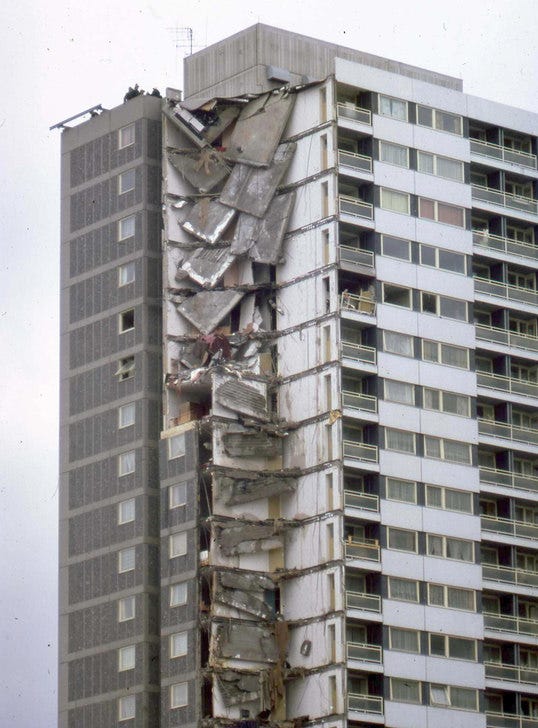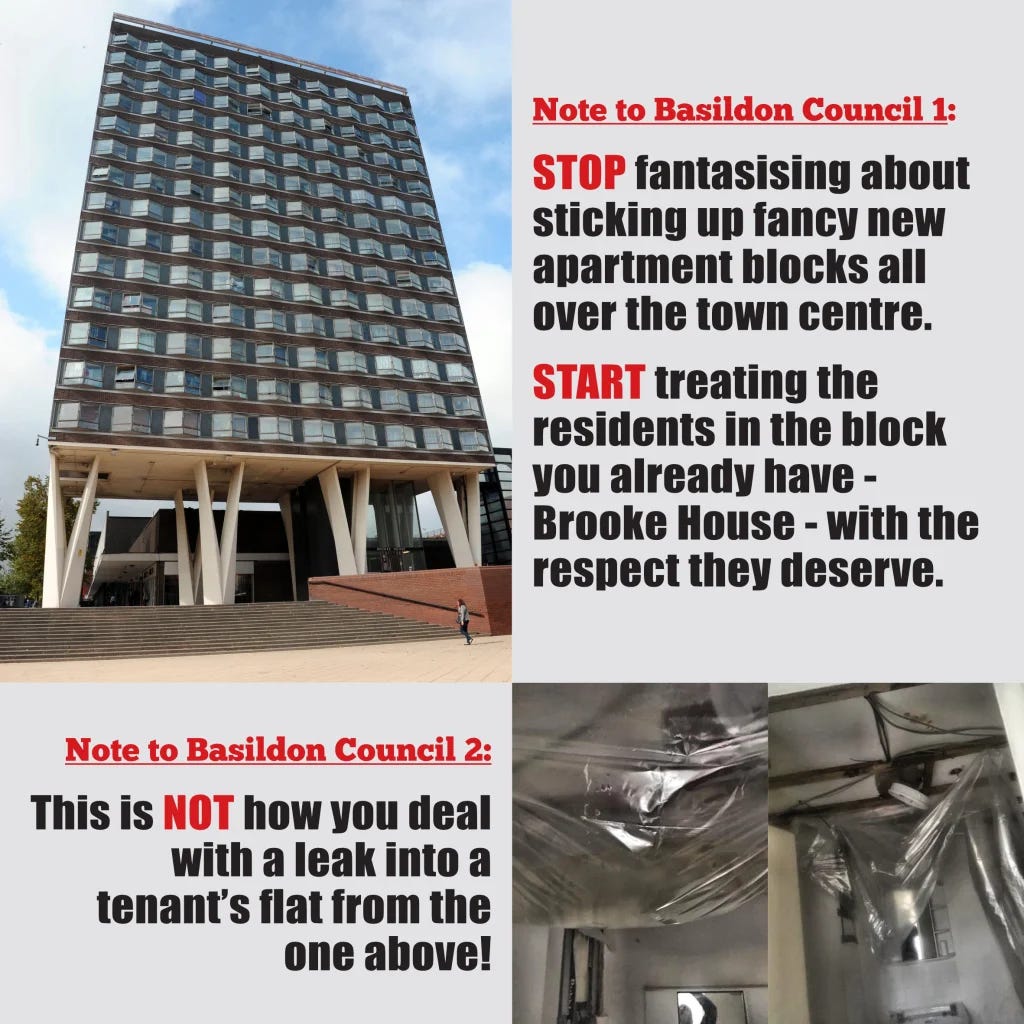During the evening of Tuesday 14.11, around 400 residents in Barton House, a high rise block of flats in the Barton Hill area of Bristol, were told they had to evacuate their homes as soon as possible due to potentially serious structural issues with the building: Fear and uncertainty in wake of sudden evacuation of Barton House - Elle Pipe | B24/7 | 15.11.23. Bristol City Council had been carrying out a long overdue structural survey of the block which was built in 1958 as part of the process of deciding its long term future when the issues with its safety were 'discovered'.
The safety issues are to do with what would happen in the event of a fire in the block. Tower blocks built using the Large Panel System (LPS) in the 1950s and 1960s were supposed to be designed so that each flat formed its own self contained concrete cube. The thinking behind this was that in the event of a fire, it would be contained within the flat it had started in and the rest of the block would be safe. It transpires there's a gap between what was specified in the original architectural drawings and what actually got built.
The structural survey found that the connections between the walls and the floors were not as robust as expected. This meant that in the event of a fire, there was a likelihood that it would spread. In the event of an explosion, there were concerns that the building would not be structurally sound and there was a possible risk of collapse. There are a number of other tower blocks around Bristol that were built at the same time that are being checked as a precaution: Surveyors to check other Bristol council tower blocks after hundreds evacuated - Alex Seabrook | Bristol World | 15.11.23.
The issues uncovered at Barton House are not new at all. Awareness about them goes all the way back to the explosion at the Ronan Point tower block in Canning Town in the east London borough of Newham back in 1968:
At approximately 5:45 am on 16 May 1968, resident Ivy Hodge went into her kitchen in flat 90, a corner flat on the 18th floor of the building, and lit a match to light the gas stove for a cup of tea. The match sparked a gas explosion that blew out the load-bearing flank walls, which had been supporting the four flats above. It is believed that the weaknesses were in the joints connecting the vertical walls to the floor slabs. The flank walls fell away, leaving the floors above unsupported and causing the progressive collapse of the south-east corner of the building.
(The bold emphasis is ours)

In the wake of the collapse of Ronan Point, the government commissioned an inquiry, led by Hugh Griffiths, QC. It reported on dangers caused by pressure on the walls from explosion, wind, or fire, finding that although the design had complied with the current regulations, the following recommendations should be implemented:
Gas supplies should be disconnected from existing tall buildings until they have been strengthened.
Consideration should be given to a requirement to notify the gas board of new gas installations.
Consideration should be given to improving ventilation in high blocks.
The regulations for the storage of explosive materials in high blocks should be reviewed.
All blocks over six storeys should be appraised by a structural engineer.
Where necessary high blocks should be strengthened.
Designers of new tall blocks should design them so they are not susceptible to progressive collapse.
Designers should have regard to recent research on frequency and duration of high wind speeds etc.
Designers should have regard to the effects of fire on the structural behaviour of the building.
This is a very useful piece looking at the historic issues with blocks of flats built using the LPS construction method that was used for Barton House: Analysis: The national high-rise saga behind Barton House’s emergency evacuation - Peter Apps | The Bristol Cable | 16.11.23:
After World War II, there was a national drive to build a generation of urban social housing and ministers wanted councils to get as much housing as possible out of the land they had available.
As a result, they told them to build upwards. The grant subsidy system was engineered to actively encourage the construction of a new generation of high rise tower blocks.
The tower blocks which form the skyline of many of our cities rose from the ground in the three decades after World War II thanks to this drive. But many of these blocks were built on the cheap.
According to this article - Experts warned government of tower block collapse risk last year, leak reveals - The Guardian | 16.11.23 - Bristol City Council have said there's no record of any structural survey having been carried out on Barton House since remedial works were carried out around 1970. As much as a lot of Bristolians understandably want to put the boot in on the mayor, Marvin Rees, and the current administration, the evidence points to this being a decades old story of systemic neglect.
It now turns out that four other blocks - all in St Jude’s area - were built using the same LPS construction method. Back in 2017, the Government’s building safety department told council chief executives across the country to investigate these blocks: Government warned Bristol City Council about Barton House and four other blocks in 2017 - Tristan Cork | Bristol Post | 16.11.23.
Bristol City Council, and probably a lot of other local authorities as well, have been sitting on their hands since these warnings in 2017 instead of pulling their finger out and conducting the investigations needed in a timely manner. So, we now have a major crisis unfolding with 400 residents urgently needing to be found alternative accommodation in the short to medium term at least. You couldn't make it up, could you?
This is a crisis born of decades of regarding social housing as something to be grudgingly provided instead of something to be celebrated. From the shoddy construction standards endemic from the late 1950s onwards through to slack and botched maintenance, social housing tenants constantly get the message that their needs don't matter. Issues we wrote about when we used to live back in Essex a few years ago - these are just some of the posts we published: Not f**king fit for purpose… 21.1.22 and this: Thurrock Council trying to squirm out of their responsibility for dire housing conditions 22.6.21 and this as well: Seriously, how long does it take to fix a leak?! 23.2.21.
The only glimmer of hope that may emerge from this latest crisis with Barton House is that it will shame the authorities into taking maintenance of their social housing stock seriously instead of the too little, too late approach which ends in a crisis that has been the norm for decades. Certainly in Bristol, there are community groups vigorously challenging the city council over their housing policy, groups that are now upping the pressure they're applying to the next level. Here's one of them: ACORN Bristol.
This is a developing situation so, there will be more posts to come. This one has intentionally focused on the decades of systemic neglect that have led to the current crisis. There are other aspects such as how the evacuation of the residents of Barton House has been handled and what their future will look like that other people have written about. What's important and heartening is the level of solidarity and the support that's being offered by a range of community groups to the displaced residents. As ever, when a crisis hits, it's ordinary people rallying around who make a crucial difference - this is what gives us a degree of hope for the future...







Terrific research, sir.